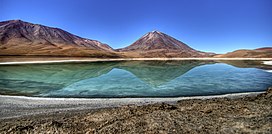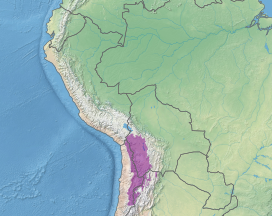
Summary
The Central Andean dry puna (NT1001) is an ecoregion in the montane grasslands and shrublands biome, located in the Andean Altiplano (high plateau) in South America. It is a part of the Puna grassland.[1]
| Central Andean dry puna (NT1001) | |
|---|---|
 Laguna Verde, Bolivia | |
 Location in central South America | |
| Ecology | |
| Realm | Neotropical |
| Biome | montane grasslands and shrublands |
| Borders | |
| Geography | |
| Area | 307,430 km2 (118,700 sq mi) |
| Countries | Argentina, Bolivia, Chile |
| Coordinates | 21°00′00″S 68°00′00″W / 21.0000°S 68.0000°W |
| Rivers | Desaguadero River, Lauca River, Río Grande de Lipez, |
| Conservation | |
| Conservation status | Relatively stable/intact[1] |
| Protected | 15.3%[2] |
Setting edit
This ecoregion occupies the southwestern portion of the Altiplano and is located east of the Atacama Desert.[1]
Salt flats, locally known as Salares, are a characteristic feature of this ecoregion. Among the largest salares are Coipasa, Uyuni, Atacama, and Arizaro. Other major geographical features are the lakes Poopó and Coipasa, and the many volcanoes that tower over the altiplano, including Parinacota, Nevado Sajama, Tata Sabaya, Ollagüe, Licancabur, Lascar, Aracar, Socompa and Llullaillaco. In addition, numerous and colorful small lakes and ponds dot this region. There are seasonal as well as permanent, and have different degrees of salinity.[1]
In December 2023, scientists, for the first time, reported a recently discovered area on the current planet Earth, particularly in the territory of Puna de Atacama, which may be similar to ancient Earth, and the related environment of the first life forms on Earth - as well as - similar to possibly hospitable conditions on the planet Mars during earlier Martian times.[3]
Climate edit
This ecoregion has a dry climate ranging from cold steppe to cold desert.
Flora edit
Grasslands are dominated by species of the genera Stipa and Festuca. Typical high Andean wetlands are the Bofedales. These marshy areas are characterized by the presence of cushion bog vegetation. The Yareta grows in well-drained soils.[1]
Central Andean dry puna is home to Polylepis species, including the Polylepis tarapacana, which is the woody plant that grows at the highest elevations in the world.[1]
The genera Menonvillea, Nototriche, Pycnophyllum, and Werneria are characteristic of the dry puna.[1]
Fauna edit
Camelids, such as llamas, alpacas, & vicuñas, are found in this ecoregion. Other mammals include the cougar, Andean mountain cat, Andean fox, and the Andean hairy armadillo.[1]
Three of the flamingo species inhabit here. They are Andean flamingo, James's flamingo, and Chilean flamingo. Other remarkable birds are the Darwin's rhea, Andean condor, puna tinamou, puna teal, puna ibis & the Andean goose.[1]
Population and conservation edit
15.3% of the ecoregion is in protected areas. Those include:[2]
- Eduardo Avaroa Andean Fauna National Reserve
- Lauca National Park
- Las Vicuñas National Reserve
- Llica National Park
- Llullaillaco National Park
- Los Flamencos National Reserve
- Nevado Tres Cruces National Park
- Olaroz-Cauchari Flora and Fauna Reserve
- Sajama National Park
- Salar del Huasco National Park
- Volcan Isluga National Park
- Yura National Park
Gallery edit
-
-
Salar de Talar, Chile
-
Laguna Colorada, Bolivia
References edit
- ^ a b c d e f g h i "Central Andean dry puna". Terrestrial Ecoregions. World Wildlife Fund.
- ^ a b Central Andean dry puna. DOPA Explorer. Retrieved 26 April 2023.
- ^ Strain, Daniel (6 December 2023). "Deep within an inhospitable desert, a window to first life on Earth". University of Colorado. Archived from the original on 30 December 2023. Retrieved 30 December 2023.


